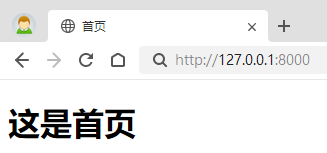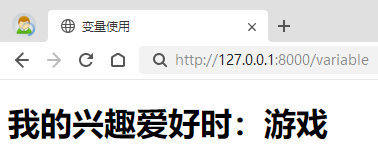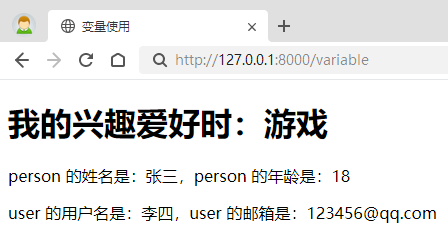渲染模板
1 <!DOCTYPE html>
2 <html lang="en">
3 <head>
4 <meta charset="UTF-8">
5 <title>首页</title>
6 </head>
7 <body>
8 <h1>这是首页</h1>
9 </body>
10 </html>
1 @app.route('/')
2 def index():
3 return render_template('index.html')
![]()
渲染变量
1 <!DOCTYPE html>
2 <html lang="en">
3 <head>
4 <meta charset="UTF-8">
5 <title>变量使用</title>
6 </head>
7 <body>
8 <h1>我的兴趣爱好时:{{ hobby }}</h1>
9 </body>
10 </html>
1 @app.route('/variable')
2 def variable():
3 hobby = '游戏'
4 return render_template('variable.html', hobby=hobby)
![]()
变量为字典和对象
1 <!DOCTYPE html>
2 <html lang="en">
3 <head>
4 <meta charset="UTF-8">
5 <title>变量使用</title>
6 </head>
7 <body>
8 <h1>我的兴趣爱好时:{{ hobby }}</h1>
9 <p>person 的姓名是:{{ person.name }},person 的年龄是:{{ person.age }}</p>
10 <p>user 的用户名是:{{ user.username }},user 的邮箱是:{{ user.email }}</p>
11 </body>
12 </html>
1 @app.route('/variable')
2 def variable():
3 hobby = '游戏'
4 person = {
5 "name": "张三",
6 "age": 18
7 }
8 user = User("李四", "123456@qq.com")
9 return render_template('variable.html', hobby=hobby, person=person, user=user)
![]()
变量较多的情况
1 @app.route('/variable')
2 def variable():
3 hobby = '游戏'
4 person = {
5 "name": "张三",
6 "age": 18
7 }
8 user = User("李四", "123456@qq.com")
9 context = {
10 "hobby": hobby,
11 "person": person,
12 "user": user
13 }
14 return render_template('variable.html', **context)







 浙公网安备 33010602011771号
浙公网安备 33010602011771号